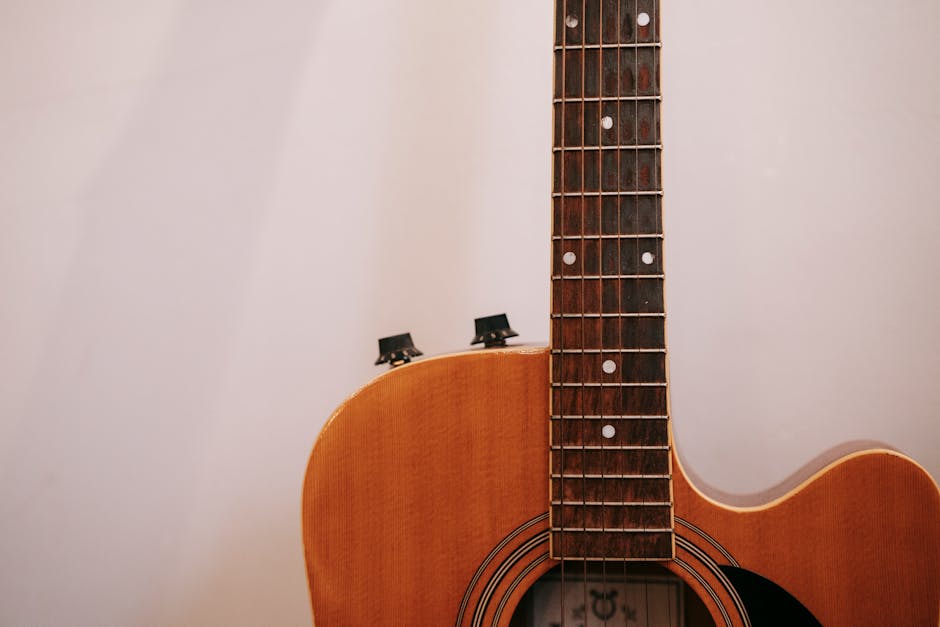So you’ve picked up a guitar, strummed a few chords, and managed to not lose a finger in the process – congratulations! But now it’s time to take your skills to the next level and conquer the core chords like a true rockstar. In this article, we’ll show you the essential steps for mastering the basic chords that every beginner guitarist needs in their repertoire. Get ready to rock and roll (or maybe just gently strum) your way to guitar greatness!
Contents
- 1 Understanding the Basics of Guitar Chords
- 2 Exploring Open Chords: The Foundation of Guitar Playing
- 3 Transitioning Between Chords Smoothly and Efficiently
- 4 Building Finger Strength and Dexterity for Chord Mastery
- 5 Incorporating Strumming Patterns to Enhance Chord Progressions
- 6 Expanding Your Chord Vocabulary with Barre Chords
- 7 Practice Strategies for Achieving Chord Proficiency and Confidence
- 8 FAQs
- 9 Rock on, beginners!
Understanding the Basics of Guitar Chords
Alright, let’s dive into the wild world of guitar chords! Forget about complex music theory for now, we’re keeping it simple and fun here.
First off, what exactly is a chord? Well, it’s basically a combination of two or more notes played simultaneously. When strummed on a guitar, chords create those magical sounds that make your heart sing (or maybe cringe, if you’re still learning).
Now, onto the good stuff – the different types of chords you’ll encounter. Here’s a cheat sheet for you:
- Major – the happy, go-to chords that make you feel like sunshine and rainbows.
- Minor – the moody, melancholic chords that make you want to write a breakup song.
- Dominate – the powerful, ”I am the king/queen of this chord progression” chords that demand attention.
Remember, practice makes perfect when it comes to mastering guitar chords. So grab that guitar, strum away, and impress all your friends with your newfound chord knowledge. Rock on!

Exploring Open Chords: The Foundation of Guitar Playing
So you’ve decided to embark on the noble journey of becoming a guitar virtuoso. Congratulations! But before you start shredding like a rock god, you must first master the basics: open chords.
Open chords are like the building blocks of guitar playing. They form the foundation upon which all other guitar skills are built. Without a solid understanding of open chords, you might as well be strumming a rubber band tied to a shoebox. But fear not, young grasshopper, for I am here to guide you on this mystical quest.
Imagine open chords as the ingredients in a magical potion that transforms ordinary humans into guitar wizards. Each chord has its own unique flavor, its own special twist that adds depth and color to your music. Once you master these chords, the possibilities are endless.
So grab your guitar, tune up those strings, and get ready to dive headfirst into the enchanting world of open chords. Trust me, once you unlock the secrets of these humble yet powerful chords, you’ll be well on your way to guitar greatness.

Transitioning Between Chords Smoothly and Efficiently
When it comes to playing the guitar, one of the biggest challenges is . You may have mastered the individual chords, but when it comes to putting them together in a song, things can get a little…clunky. Like the sound of a car engine sputtering to life on a cold winter morning.
But fear not, dear strummer! With a little practice and some handy tips, you’ll be switching between chords like a pro in no time. And who knows, maybe you’ll even impress your friends with your newfound guitar wizardry.
First things first, make sure your fingers are positioned properly on the fretboard. No, that doesn’t mean trying to contort them into some weird, unnatural position that would make a contortionist cringe. Keep your fingers relaxed and close to the strings to reduce the distance they have to travel between chords.
Next, focus on the timing of your chord changes. Remember, it’s not a race to see how quickly you can switch between chords. Take your time and make sure each chord sounds clear and crisp before moving on to the next one. And if you need to, practice each chord change individually before putting them together in a song.
Building Finger Strength and Dexterity for Chord Mastery
So you want to master those tricky guitar chords, huh? Well, you’ve come to the right place! Building finger strength and dexterity is key to unlocking chord mastery. It’s like giving your fingers a workout at the gym, except you get to make beautiful music at the end!
One way to build finger strength is by practicing scales. Scales are like the vegetables of guitar playing - you may not always want to eat them, but they’re good for you! Start with simple scales like the major scale and work your way up to more complex ones. Your fingers will thank you later!
Another fun way to build finger strength is by playing finger exercises. Think of them as push-ups for your fingers! Try out exercises like finger rolls, spider crawls, and hammer-ons/pull-offs. Your fingers will be ripped in no time!
A final tip for building finger strength and dexterity is to practice chord transitions. Transitions are like the dance moves of guitar playing – smooth and effortless! Pick two chords that you struggle with and practice switching between them over and over again. Soon enough, you’ll be transitioning like a pro!

Incorporating Strumming Patterns to Enhance Chord Progressions
Are you tired of your chord progressions sounding bland and uninspiring? Well, fear not, my friends! By incorporating strumming patterns into your playing, you can take your chord progressions from snoozeville to rockin’ town in no time!
Strumming patterns add rhythm and flair to your playing, transforming simple chords into toe-tapping masterpieces. With just a flick of the wrist and a tap of the foot, you can turn a boring old G-C-D progression into a funky, groovy jam that will have your audience begging for more!
So how do you incorporate strumming patterns into your chord progressions? It’s simple, really. Just follow these easy steps:
- Choose a strumming pattern that complements the mood of your song. Are you going for a laid-back vibe? Try a slow, steady strum. Want to kick things up a notch? Go for a quick, syncopated strum.
- Practice, practice, practice! Get comfortable with the strumming pattern before adding it to your chord progression. It may take some time to get the hang of it, but trust me, it’s worth it!
- Experiment with different strumming patterns to see which one works best for each chord progression. Don’t be afraid to mix things up and get creative!
Remember, the key to incorporating strumming patterns into your chord progressions is to have fun and let your creativity shine. So grab your guitar, strum away, and get ready to take your playing to the next level!
Expanding Your Chord Vocabulary with Barre Chords
So, you’ve mastered your basic open chords and you’re ready to take your guitar playing to the next level. Enter the infamous barre chords - the ultimate test of finger strength and dexterity! Don’t fret (pun intended), we’re here to guide you through the treacherous waters of barre chords and expand your chord vocabulary like never before.
First things first, let’s talk technique. The key to mastering barre chords is all in the wrist… and the fingers, and the arm, and pretty much every part of your body. Make sure you’re using the correct form and positioning your fingers just right to get that perfect sound. It may take some time to build up the necessary finger strength, but trust us, the calluses will be worth it in the end!
When it comes to barre chords, the fretboard is your oyster. With just one shape, you can play a multitude of different chords up and down the neck. Experiment with moving the shape around and see how many new chords you can come up with. The possibilities are endless!
Now, it’s time to put your newfound knowledge into practice. Grab your guitar, grab your favorite songbook, and start substituting those basic open chords with some spicy barre chords. Your audience won’t know what hit them when they hear those bodacious new sounds coming from your guitar. Rock on, and may the barre be ever in your favor!
Practice Strategies for Achieving Chord Proficiency and Confidence
So you want to become a master of chords, huh? Well, you’ve come to the right place! Here are some practice strategies that will help you achieve chord proficiency and confidence faster than you can say “G major”.
First off, don’t be afraid to experiment. Try out different finger placements and find what works best for you. Remember, there’s no one-size-fits-all approach to playing chords, so don’t be afraid to get a little creative.
Next, practice regularly. Like, every day. Consistency is key when it comes to mastering chords, so make sure to carve out some time in your schedule for daily practice sessions. Your fingers will thank you.
And don’t forget to challenge yourself. Once you’ve mastered the basic chords, try tackling some more advanced ones. Push yourself out of your comfort zone and watch your confidence soar as you conquer those tricky barre chords like a boss.
FAQs
Why are core chords important for guitar beginners?
Well, if you want to sound like a rockstar and not just like you’re strumming random strings on a guitar, mastering core chords is key. They form the foundation for many songs and will help you progress in your guitar playing journey.
What are the essential steps to mastering core chords?
Step 1: Learn the basic open chords like G, C, D, A, E, and Em. These bad boys will be your best friends on the guitar.
Step 2: Practice transitioning between chords. It’s like playing a game of musical Twister, but with your fingers.
Step 3: Play along with songs you love. It’s more fun to practice when you feel like a rockstar.
How often should I practice my core chords?
As often as you want to become a guitar god! But really, consistency is key. Aim for at least 15-30 minutes a day to see progress.
What should I do if I can’t seem to get a chord right?
Don’t fret (pun intended)! Take a break, shake out your hand, and come back to it later. Rome wasn’t built in a day, and neither was Jimi Hendrix’s guitar prowess.
Can I use online resources to help me master core chords?
Absolutely! There are tons of YouTube tutorials, websites, and apps that can help guide you through the world of core chords. Just don’t get lost in a black hole of cat videos while you’re at it.
Rock on, beginners!
Congratulations on taking the first step towards mastering the core chords on your guitar journey! Remember, Rome wasn’t built in a day, and neither was Jimi Hendrix’s guitar-playing prowess. Keep practicing, keep strumming, and keep rocking out those chords like a pro.
So go ahead, grab your guitar, crank up the amp, and show off your newfound skills to your friends and family. And who knows, maybe one day you’ll be headlining at Wembley Stadium or shredding like Slash on stage. The sky’s the limit, so keep strumming and keep on rocking!
Until next time, keep on jamming and never stop rocking those core chords!🤘🎸



